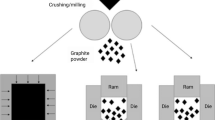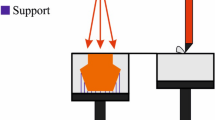Abstract
Originally developed decades ago, the binder jetting additive manufacturing (BJ-AM) process possesses various advantages compared to other additive manufacturing (AM) technologies such as broad material compatibility and technological expandability. However, the adoption of BJ-AM has been limited by the lack of knowledge with the fundamental understanding of the process principles and characteristics, as well as the relatively few systematic design guideline that are available. In this work, the process design considerations for BJ-AM in green part fabrication were discussed in detail in order to provide a comprehensive perspective of the design for additive manufacturing for the process. Various process factors, including binder saturation, in-process drying, powder spreading, powder feedstock characteristics, binder characteristics and post-process curing, could significantly affect the printing quality of the green parts such as geometrical accuracy and part integrity. For powder feedstock with low flowability, even though process parameters could be optimized to partially offset the printing feasibility issue, the qualities of the green parts will be intrinsically limited due to the existence of large internal voids that are inaccessible to the binder. In addition, during the process development, the balanced combination between the saturation level and in-process drying is of critical importance in the quality control of the green parts.
Similar content being viewed by others
References
Sachs E, Cima M, Cornie J, et al. Three-dimensional printing: Rapid tooling and prototypes directly from CAD representation. CIRP Annals-Manufacturing Technology, 1990, 39(1): 201–204
Yoo J, Cima M J, Khanuja S, et al. Structural ceramic components by 3D printing. In: Proceedings of International Solid Freeform Fabrication (SFF) Symposium. Austin, 1993
Utela B, Anderson R L, Kuhn H. Advanced ceramic materials and processes for three-dimensional printing (3DP). In: Proceedings of International Solid Freeform Fabrication (SFF) Symposium. Austin, 2006, 290–303
Lanzetta M, Sachs E. Improved surface finish in 3D printing using bimodal powder distribution. Rapid Prototyping Journal, 2003, 9(3): 157–166
Gonzalez J A, Mireles J, Lin Y, et al. Characterization of ceramic components fabricated using binder jetting additive manufacturing technology. Ceramics International, 2016, 42(9): 10559–10564
Yoo J, Cima M, Sachs E, et al. Fabrication and microstructural control of advanced ceramic components by three dimensional printing. Ceramic Engineering and Science Proceedings, 1995, 16 (5): 755–762
Moon J, Caballero A C, Hozer L, et al. Fabrication of functionally graded reaction infiltrated SiC-Si composite by three-dimensional printing (3DP) process. Materials Science and Engineering A, 2001, 298(1–2): 110–119
Grau J, Moon J, Uhland S, et al. High green density ceramic components fabricated by the slurry-based 3DP process. In: Proceedings of International Solid Freeform Fabrication (SFF) Symposium. Austin, 1997
Moon J, Grau J E, Cima M J, et al. Slurry chemistry control to produce easily redispersible ceramic powder compacts. Journal of the American Ceramic Society, 2000, 83(10): 2401–2408
Bergmann C, Lindner M, Zhang W. et al. 3D printing of bone substitute implants using calcium phosphate and bioactive glasses. Journal of the European Ceramic Society, 2010, 30(12): 2563–2567
Butscher A, Bohner M, Roth C, et al. Printability of calcium phosphate powders for three-dimensional printing of tissue engineering scaffolds. Acta Biomaterialia, 2012, 8(1): 373–385
Winkel A, Meszaros R, Reinsch S, et al. Sintering of 3D-printed glass/HAp composites. Journal of the American Ceramic Society, 2012, 95(11): 3387–3393
Ott A, Heinzl J, Janitza D, et al. Fabrication of bone substitute material by rapid prototyping. Virtual Modeling and Rapid Manufacturing, 2004, 133–138
D’Costa D J, Dimovski S D, Lin F, et al. Three-dimensional printing of layered machinable ductile carbide. In: Proceedings of International Solid Freeform Fabrication (SFF) Symposium. Austin, 2000
Gaytan S M, Cadena M A, Karim H, et al. Fabrication of barium titanate by binder jetting additive manufacturing technology. Ceramics International, 2015, 41(5): 6610–6619
Manogharan G, Kioko M, Linkous C. Binder jetting: A novel solid oxide fuel-cell fabrication process and evaluation. Journal of Materials, 2015, 67(3): 660–667
Guo D. Vector drop-on-demand production of tungsten carbidecobalt tooling inserts by three dimensional printing. Thesis for the Master’s Degree. Boston: Massachusetts Institute of Technology, 2004
Utela B, Storti D, Anderson R, et al. A review of process development steps for new material systems in three dimensional printing (3DP). Journal of Manufacturing Processes, 2008, 10(2): 96–104
Maleksaeedi S, Eng H, Wiria F E, et al. Property enhancement of 3D-printed alumina ceramics using vacuum infiltration. Journal of Materials Processing Technology, 2014, 214(7): 1301–1306
Yao D, Gomes C M, Zeng Y P, et al. Near zero shrinkage porous Al2O3 prepared via 3D-printing and reaction bonding. Materials Letters, 2015, 147: 116–118
Miyanaji H, Zhang S, Lassell A, et al. Process development of porcelain ceramic material with binder jetting process for dental applications. Journal of Materials, 2016, 68(3): 831–841
Holman R K, Uhland S A, Cima M J, et al. Surface adsorption effects in the inkjet printing of an aqueous polymer solution on a porous oxide ceramic substrate. Journal of Colloid and Interface Science, 2002, 247(2): 266–274
Uhland S, Holman R, DeBear B, et al. Three-dimensional printing, 3DP, of electronic ceramic components. In: Proceedings of International Solid Freeform Fabrication (SFF) Symposium. Austin, 1999
Cima M J, Oliveira M, Wang H R, et al. Slurry-based 3DP and fine ceramic components. In: Proceedings of International Solid Freeform Fabrication (SFF) Symposium. Austin, 2001
Dimitrov D, de Beer N. Developing capability profile for the three dimensional printing process. Research and Development (R&D) Journal of the South African Institution of Mechanical Engineering, 2006, 22: 17–25
Stopp S, Wolff T, Irlinger F, et al. A new method for printer calibration and contour accuracy manufacturing with 3D-print technology. Rapid Prototyping Journal, 2008, 14(3): 167–172
Asadi-Eydivand M, Solati-Hashjin M, Farzad A, et al. Effect of technical parameters on porous structure and strength of 3D printed calcium sulfate prototypes. Robotics and Computer-integrated Manufacturing, 2016, 37: 57–67
Johnston S, Anderson R, Storti D. Particle size influence upon sintered induced strains within 3DP stainless steel components. In: Proceedings of International Solid Freeform Fabrication (SFF) Symposium. Austin, 2003
Bai Y, Wagner G, Williams C B. Effect of bimodal powder mixture on powder packing density and sintered density in binder jetting of metals. In: Proceedings of International Solid Freeform Fabrication (SFF) Symposium. Austin, 2015
Bai Y, Williams C B. An exploration of binder jetting of copper. Rapid Prototyping Journal, 2015, 21(2): 177–185
Zhang S, Minayaji H, Yang L, et al. An experimental study of ceramic dental porcelain materials using a 3D print (3DP) process. In: Proceedings of International Solid Freeform Fabrication (SFF) Symposium. Austin, 2014
Farzadi A, Waran V, Solati-Hashjin M, et al. Effect of layer printing delay on mechanical properties and dimensional accuracy of 3D printed porous prototypes in bone tissue engineering. Ceramics International, 2015, 41(7): 8320–8330
Lu K, Reynolds W T. 3DP process for fine mesh structure printing. Powder Technology, 2008, 187(1): 11–18
Shanjani Y, Toyserkani E. Material spreading and compaction in powder-based solid freeform fabrication methods: Mathematical modeling. In: Proceedings of International Solid Freeform Fabrication (SFF) Symposium. Austin, 2008
Niino T, Sato K. Effect of powder compaction in plastic laser sintering fabrication. In: Proceedings of International Solid Freeform Fabrication (SFF) Symposium. Austin, 2009
Budding A, Vaneker T H J. New strategies for powder compaction in powder-based rapid prototyping techniques. Procedia CIRP, 2013, 6: 527–532
Haeri S, Wang Y, Ghita O, et al. Discrete element simulation and experimental study of powder spreading process in additive manufacturing. Powder Technology, 2017, 306: 45–54
Rein M. Phenomena of liquid drop impact on solid and liquid surfaces. Fluid Dynamics Research, 1993, 12(2): 61–93
Acknowledgements
The authors would like to acknowledge the support of Rapid Prototyping Center (RPC) at University of Louisville and the many technical insights and discussions from Dan Brunermer at ExOne LLC. This work was partially supported by National Science Foundation (Grant No. 1450370, subaward No. OGMN131508E4).
Author information
Authors and Affiliations
Corresponding author
Rights and permissions
About this article
Cite this article
Miyanaji, H., Orth, M., Akbar, J.M. et al. Process development for green part printing using binder jetting additive manufacturing. Front. Mech. Eng. 13, 504–512 (2018). https://doi.org/10.1007/s11465-018-0508-8
Received:
Accepted:
Published:
Issue Date:
DOI: https://doi.org/10.1007/s11465-018-0508-8




